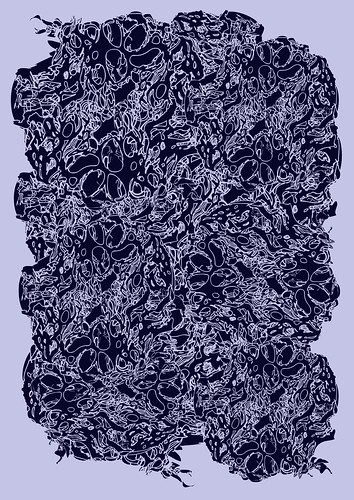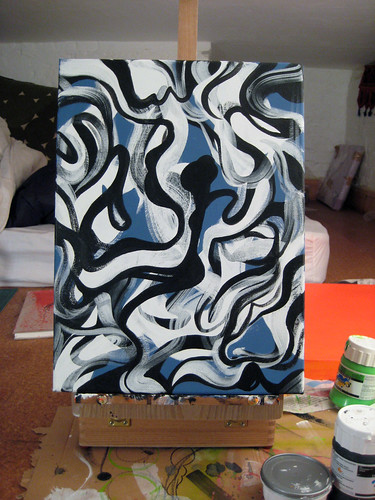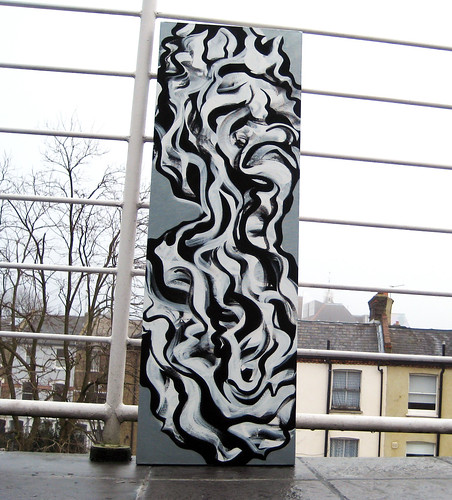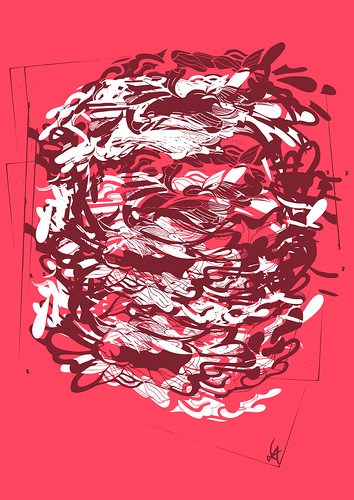
Q1: Hello, Dan. Can you talk a bit about how your art work begin?
A:
I was always interested in art and design. I started drawing and painting with more of a direction and purpose in about 2003. It feels like everything from then until now has really been practice for what now seems to be developing into a consistent and interesting style. It's all learning though, I actually look forward to being older sometimes because if I look at work from 5 years ago compared to how it looks now, it's exciting to think about to how it might develop in the future. I think time, maturity and life experience really help when making art.
Q2: Are there any particular influences throughout your artistic career, e.g. other artists, certain types of music, certain social phenomenon etc.?
A:
I've followed urban/street art a lot in recent years. Street artists have incredible ideas about how to attract attention. I'm fascinated by the layering and decay of spray paint and paste ups on walls and how work can be seen as temporary. If you look at a wall that has layers and layers of tags, half ripped down paste ups, showing other stuff underneath it kind of makes a really natural, organic composition that is near impossible to re-create. This is why I admire the work of Conor Harrington, an artist who has grown up with graffiti and urban art and can mix his knowledge of both this and an aptitude for oil painting as well to create incredible compositions on walls or canvas. I like the work of Will Barras, also a nice mix of more traditional skill and urban influence.
I'm always listening to music. I prefer anything experimental, or music that once pushed boundaries and is now influential. Music helps me concentrate and get lost in drawing or painting. It sections me off from the rest of the world when I'm in my studio.
As far as social phenomena are concerned. I don't think we can ignore technology these days. Sites such as Flickr are an invaluable resource for me as an artist, then there are all the other social networking sites, blogging etc., which have changed the way that many of us communicate, read and spend our time. My work is definitely influenced by technology from being in this mindset and also from the tools that I use to create art. I can achieve things with a computer that I couldn't do without one.
Personal experience is also a major influence. I've been to some pretty extreme places both physically and psychologically in recent times. I can only hope that these experiences can manifest them in the art and give my paintings and drawings content and emotion. Content is something I had previously struggled with, being an abstract artist.
This piece is one that reflects my personal experience:

Blue Death (C) Daniel Abbott
Q3: About the abstract noodles/spaghetti/whatever that you paint, are they generated by any kind of consciousness? Or just "let-it-flow and beautiful" attempts?
A:
It's a relatively sub-concious way of working. I have the idea that I want to draw or paint shapes, and that I want them to end up in a relatively coherent composition. But, it's more about what feels right to put down on canvas or on paper at the time. The compositions come from working with layers of lines, shapes and doodles. If something looks bad, I can add another layer so that only some of what is underneath shows through. This way, I can achieve a certain depth and not get too bogged down with trying to make something look perfect first time.
It's a relatively sub-concious way of working. I have the idea that I want to draw or paint shapes, and that I want them to end up in a relatively coherent composition. But, it's more about what feels right to put down on canvas or on paper at the time. The compositions come from working with layers of lines, shapes and doodles. If something looks bad, I can add another layer so that only some of what is underneath shows through. This way, I can achieve a certain depth and not get too bogged down with trying to make something look perfect first time.
Examples in a paiting of work that reflects this process are these:

Can't Stop (C) Daniel Abbott

Midnight II (C) Daniel Abbott

Squeeze-fin (C) Daniel Abbott
The way I work with digital images is much the same, I'll start with a drawing in my sketchbook, scan it in and then pick parts of the doodle, warp it, repeat it and layer it. Then I'll delete parts of it, or add parts of another drawing. It's all done in a pretty fluid motion though, without too much thinking or precise method. I end up with loads of layers and paths and stuff, so I can get a bit lost in Illustrator or Photoshop, but I prefer it this way. Haphazard and always welcoming accidents.
A good example of digital work that reflects this process is this one:

Symmetry Subtle Remix (C) Daniel Abbott
Q4: I know another artist moving from London to Bristol. You did the other way round. Can you share how you feel about the 2 places in terms of work/life/creativity etc.?
A:
That's an interesting question. My friends in Bristol all manage to sustain their creativity there, and the city seems to have a massively creative vibe for it's size. I guess the community is more concentrated in Bristol.
In London, it's more difficult to enter these communities, but the city itself is an extraordinay metropolis with many influences that present themselves as inspiration as soon as you walk out the door. Whether it's the battle for space that Londoners are all subjected to, the diversity of cultures living in neighbouring areas of every borough, or the absolute wealth of exhibitions of art across all disciplines all the time.
Q5: Do you have any future plans? What's next?
A:
I'm keeping my digital work going. I'm into T-shirts and printing at the moment.
I'd like to assemble a sort of collective for doing exhibitions and collaborating on projects, so I'm on the lookout for artists that could work well alongside my style.
*****
Thank you Daniel for sharing with us! :)
Official webpage - http://www.overstanding.co.uk
Twitter - http://twitter.com/abrocks